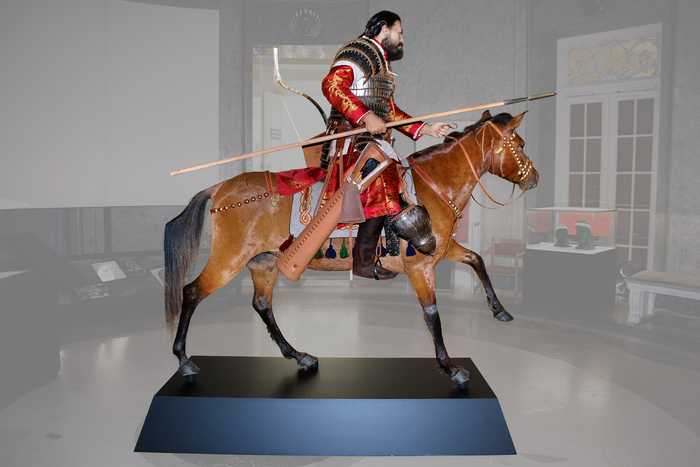In the 560s, the Avars established an empire that lasted more than 200 years, centered in the Carpathian Basin. Despite much scholarly debate, the genetic origins of the Avar elite, their initial homeland, and origin have remained unclear.
They are primarily known from historical sources of their enemies, the Byzantines, who wondered about the origin of the Avar warriors after their sudden appearance in Europe. Had they come from the Rouran empire in the Mongolian steppe (which had just been destroyed by the Turks), or should one believe the Turks who strongly disputed such a prestigious legacy?

Historians have wondered whether they were a well-organized migrant group or a mixed band of fugitives.
Origins of the Avar
Archaeological research has pointed to many parallels between the Carpathian Basin and Eurasian nomadic artifacts (weapons, vessels, horse harnesses), for instance, a lunula-shaped pectoral of gold used as a symbol of power. It’s also known that the Avars introduced the stirrup to Europe. Yet we have so far not been able to trace their origin in the wide Eurasian steppes.
Previous studies utilizing uniparental markers (Csáky et al., 2020; Neparáczki et al., 2019) have provided suggestive genetic evidence, but genome-wide data for reconstruction of the origins of the Avar-period population are missing. The researchers now used nuclear DNA to gain insights into the following questions:
1. Can the origin of a core Avar group from eastern Central Asia be confirmed from their genomic profile?
2. Were the elites of the newly arrived steppe warriors genetically homogeneous or did they have mixed ancestries?
3. How do the elites relate to the preceding local population?
Now in the study in the journal Cell, “Ancient genomes reveal origin and rapid trans-Eurasian migration of 7th century Avar elites,” a multidisciplinary team, including researchers from the Max Planck Institute for Evolutionary Anthropology in Leipzig, the ELTE University and the Institute of Archaeogenomics of Budapest, Harvard Medical School in Boston, the Austrian Academy of Sciences and the Institute for Advanced Study at Princeton, analyzed 66 individuals from the Carpathian Basin. The study included the eight richest Avar graves ever discovered, overflowing with golden objects, as well as other individuals from the region prior to and during the Avar age.
“We address a question that has been a mystery for more than 1400 years: who were the Avar elites, mysterious founders of an empire that almost crushed Constantinople and for more than 200 years ruled the lands of modern-day Hungary, Romania, Slovakia, Austria, Croatia, and Serbia?” said Johannes Krause, senior author of the study.
Fastest long-distance migration in human history
The Avars did not leave written records about their history and these first genome-wide data provide robust clues about their origins.
“The historical contextualization of the archaeogenetic results allowed us to narrow down the timing of the proposed Avar migration. They covered more than 5,000 kilometers in a few years from Mongolia to the Caucasus, and after 10 more years settled in what is now Hungary. This is the fastest long-distance migration in human history that we can reconstruct up to this point,” said Choongwon Jeong, co-senior author of the study.
“Besides their clear affinity to Northeast Asia and their likely origin due to the fall of the Rouran Empire, we also see that the 7th-Century Avar period elites show 20 to 30 percent of additional non-local ancestry, likely associated with the North Caucasus and the Western Asian Steppe, which could suggest further migration from the Steppe after their arrival in the 6th century,” said Guido Gnecchi-Ruscone, the lead author of the study.
The East Asian ancestry is found in individuals from several sites in the core settlement area between the Danube and Tisza rivers in modern-day central Hungary. However, outside the primary settlement region, high variability in inter-individual levels of admixture, especially in the south-Hungarian site of Kölked is found. This suggests an immigrant Avars elite ruling a diverse population with the help of a heterogeneous local elite.
These results show how much potential there is in the unprecedented collaboration between geneticists, archaeologists, historians, and anthropologists for the research on the “Migration period’ in the First Millennium CE.
The study’s authors are Gnecchi-Ruscone, Anna Szécsényi-Nagy, István Koncz, Gergely Csiky, Zsófia Rácz, A.B. Rohrlach, Guido Brandt, Nadin Rohland, Veronika Csáky, Olivia Cheronet, Bea Szeifert, Tibor Ákos Rácz, András Benedek, Zsolt Bernert, Norbert Berta, Szabolcs Czifra, János Dani, Zoltán Farkas, Tamara Hága, Tamás Hajdu, Mónika Jászberényi, Viktória Kisjuhász, Barbara Kolozsi, Péter Major, Antónia Marcsik, Bernadett Ny. Kovacsóczy, Csilla Balogh, Gabriella M. Lezsák, János Gábor Ódor, Márta Szelekovszky, Tamás Szeniczey, Judit Tárnoki, Zoltán Tóth, Eszter K. Tutkovics, Balázs G. Mende, Patrick Geary, Walter Pohl, Tivadar Vida, Ron Pinhasi, David Reich, Zuzana Hofmanová, Jeong, and Krause.




